EDITOR’S NOTE: Andres Salomon is an active member of NE Seattle Greenways who bikes his kid around town and cares deeply about road safety. We have been talking a lot about how protected bike lanes and walking safety could be part of the city’s plans to repave Roosevelt Way in 2015. Here are some of his thoughts on how to make a safer street and some information on how you can get involved and help make a better and safer street.
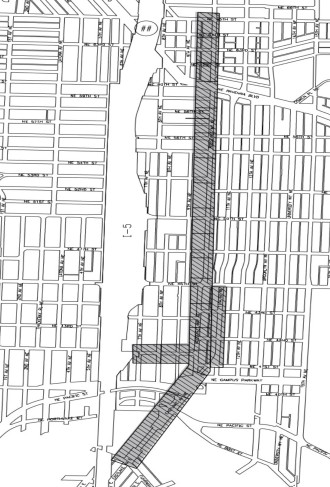
The City of Seattle is currently preparing plans to repave and restripe Roosevelt Way NE in 2015. The plan includes some minor improvements for transit riders, but is lacking in general safety improvements and bicycle facilities. This is especially important for a bicycle route that is a major backbone of the bicycle network in the city’s Bicycle Master Plan.
We can and should be asking much more from our multi-million dollar maintenance projects. Concerned neighbors are organizing community efforts to help identify needed walking and biking improvements along Roosevelt Way. A walking audit is scheduled for 5:30 p.m. Tuesday (today!), and a bike brainstorming session is scheduled for 6 p.m. Wednesday.
The repaving project includes the University Bridge (Eastlake Ave NE), Roosevelt Way NE between the University Bridge and NE 65th St, and small portions of 11th Ave NE and NE 42nd St. The currently 30 percent complete plan features widened sidewalks at bus stops and legally-required ADA-compliant curb ramps at every intersection. Where the sidewalks are to be widened, parking on one side of the street will be removed. A turn lane at the intersection of NE 45th St will also be removed, narrowing the distance that pedestrians must cross. While these are welcome improvements to the street, the restriping does little to address the numerous safety concerns with Roosevelt Way NE.
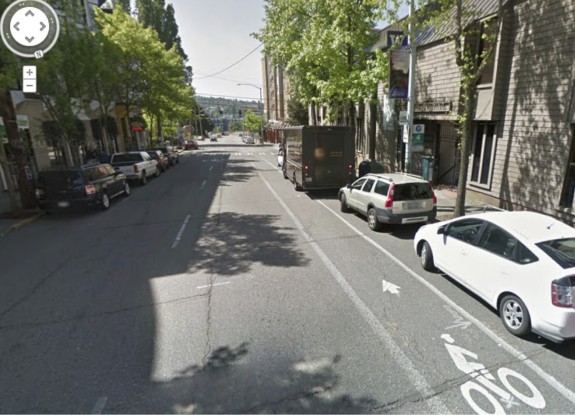
The plan maintains the currently dangerous downhill ‘door zone’ bike lane. This bike lane conflicts with buses, which are forced to block the bike lane when picking up passengers. Roosevelt Way NE is tied with downtown’s 2nd Ave as one of the most dangerous streets in Seattle for biking, going by number of collisions. Downhill speeds, combined with opening car doors, driveways, and parking garage entrances make riding on Roosevelt particularly nerve-wracking. Light rail construction vehicles also make heavy use of Roosevelt, which greatly adds to discomfort when being passed by large trucks two feet away.
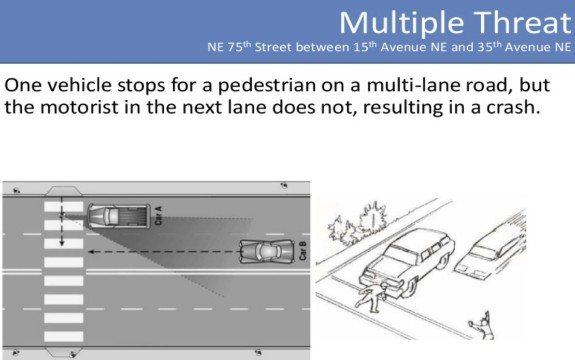
According to the city’s early plans, two general-purpose travel lanes for cars and buses will remain, creating dangerous crossings for pedestrians and delays for buses caught in general vehicle traffic. The neighborhood has long identified Roosevelt Way and 11th Ave as problem streets for pedestrians to cross. Two travel lanes lead to the deadly “multiple threat” problem faced by crossing the street on foot or bike. Planning documents such as the Roosevelt Streetscape Plan recommend making the area more pedestrian-friendly by turning Roosevelt and 11th into two-way streets. However, due to pricey traffic signal reworking required at every intersection, such a project might be cost prohibitive in the near future.
The plan also ignores the many narrow and broken sidewalks that don’t contain bus stops. This is another need that could balloon the cost of the project, but it is worth examining. Tuesday’s walking audit will help identify problems and ask Seattle’s Dept of Transportation to fix them.
We’re putting millions of dollars of Bridging The Gap and Arterial Asphalt and Concrete Program funds into this project, shouldn’t we be getting more out of it? Shouldn’t the city be proactively addressing safety concerns during maintenance projects instead of waiting for deadly collisions and community outrage to force those changes to happen?
Let’s think about some changes we can make to this corridor only using lower-cost treatments like paint, signs, and minimal sidewalk modifications that are already planned. I’m sure many other ideas will come from the upcoming community events, but here are a few ideas that I have been considering.
The biggest improvement that we could make during this repaving project for the safety and comfort of vulnerable users would be to remove a general purpose travel lane. Even if no other improvements were made, this would vastly improve pedestrian crossings, force cars to go slower (instead of rushing between traffic lights), and reduce collisions.
Average weekday vehicle traffic for the street is less than 12,000 vehicles per day (including bikes). While these numbers are merely guidelines, even doubling that falls under the 25,000 ADT threshold that Seattle uses for road diets. It’s also worth pointing out that I-5 runs parallel to Roosevelt, and is only 1,000 feet away. NE Seattle does not need Roosevelt and 11th to be 2 lanes each.
Of course, it would be silly to leave that space unused. The Bicycle Master Plan calls for protected bicycle lanes on Roosevelt as part of a city-wide all-ages-and-abilities network. Removing a general purpose travel lane leaves plenty of space for a buffered bicycle lane, which can later be upgraded to a proper protected bike lane when funds become available. Since the city is already widening sidewalks at bus stops, we could instead have Dexter-style bus islands to remove bus and bicycle conflicts.
Here’s what that might look like on Roosevelt:
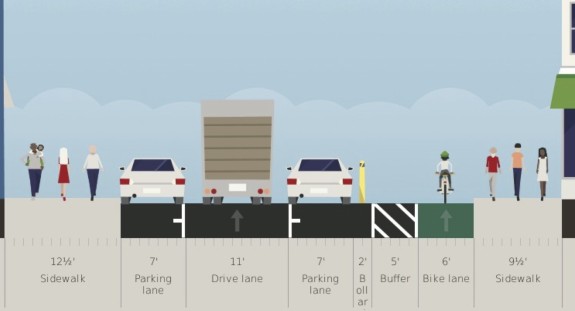
Another option for the space would be a bus-only (or Bus Rapid Transit) lane. This option would involve a longer discussion between Metro and other parties, but I wanted to point out the possibility. A bus-only lane might help with bus and bicycle conflicts, as well as keeping buses from getting stuck in general vehicle traffic. Here’s what that could look like:
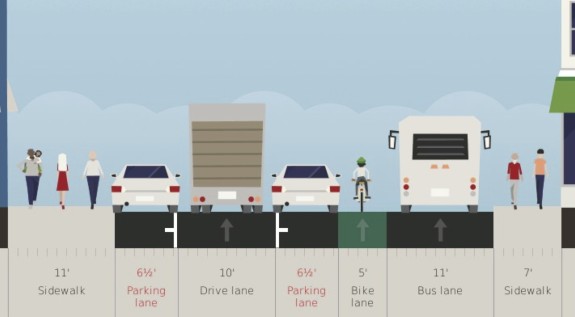 Finally, if we decided that we want both a protected bike lane and a bus-only lane, we can make space for both by removing parking on one side of the street. This would be politically contentious (as is typically the case), but would bring about a vastly improved streetscape for pedestrians, buses, and bikes. A block without a bus stop might look like this, for example:
Finally, if we decided that we want both a protected bike lane and a bus-only lane, we can make space for both by removing parking on one side of the street. This would be politically contentious (as is typically the case), but would bring about a vastly improved streetscape for pedestrians, buses, and bikes. A block without a bus stop might look like this, for example:
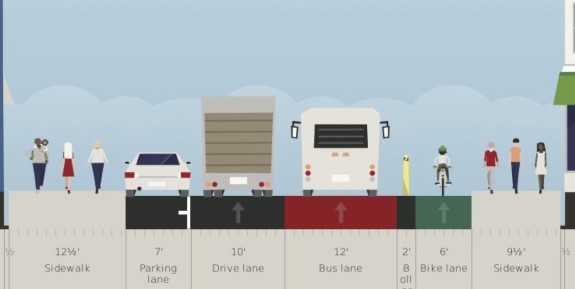 A block with a bus stop might look like this, instead:
A block with a bus stop might look like this, instead:
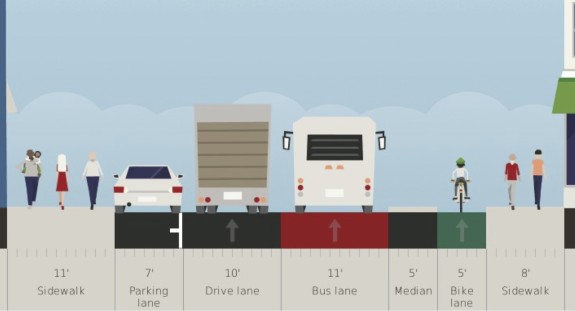 If planners do not find extra funding needed for bike-specific traffic signals and instead stick to quick, cheap, paint-only solutions, the 2015 construction could use non-protected “mixing zones” at intersections. Bikes would share a lane with buses and cars that are turning right. As funding became available, later work could focus on traffic signal upgrades that allowed bikes to safely traverse intersections without needing to mix with cars or buses.
If planners do not find extra funding needed for bike-specific traffic signals and instead stick to quick, cheap, paint-only solutions, the 2015 construction could use non-protected “mixing zones” at intersections. Bikes would share a lane with buses and cars that are turning right. As funding became available, later work could focus on traffic signal upgrades that allowed bikes to safely traverse intersections without needing to mix with cars or buses.
We should be demanding safety improvements on our city streets. It is completely unacceptable that a street known to be as dangerous as Roosevelt Way NE is not being aggressively examined for traffic calming and other improvements. I look forward to our community successfully engaging with the city to push forward on additional solutions that will Roosevelt a safer, more humane street.








Comments
41 responses to “Salomon: Safety changes need to be part of Roosevelt repaving project”
Thanks for the guest post, Andres!
FWIW, Andres takes a more cautious approach than I would have. I say: Do it right the first time. If the city’s going to spend millions on repaving, that’s the time to put in the bus islands, curbs and bike-specific traffic signals required to make this a real protected bike lane. So let’s do it. Delaying the work into two phases will only make it more costly. No need to tear up the road twice if we can just do it once.
The Roosevelt bike lane is not OK. It’s too skinny, it’s in the door zone and paint it not enough protection to make it comfortable to use. The city simply cannot spend this kind of money on repaving a street just to repaint the same mistake.
Thanks for posting it, Tom!
We talked about missed opportunities before (ie, http://www.seattlebikeblog.com/2014/06/30/south-park-bridge-is-now-open-bike-lanes-protected-for-a-week/#comment-632687 ). Let’s make sure this project doesn’t become one as well.
Drivers of the route will be terribly unhappy with one-car-lane one-way diagrams unless it is clear there are gigantic turn pockets where congestion currently happens. But you are correct that in general the entire right-of-way doesn’t need a double 2-lane couplet because capacity is not determined by the number of lanes.
Most drivers of the route coming from north of the project area probably view the extra lanes as opportunities to floor it around slow vehicles– 1.) Buses 2.) Slow drivers 3.) Bikes — Bus+Bike sharrow gets 2 of 3 out of their way.
Busses are potentially getting restructured away, though.
Tom! Roosevelt is not wide enough for all the things.
I liked Roosevelt better when we had a full 8 foot lane to take.
Now there is the generally considered dangerous bike lane that has an obnoxious problem with the parking garage ingress and egress.
My preference is to go back to reality and allow us to take the lane when necessary. The whole right lane of Roosevelt from 50th down past the bridge is an easy 20-25mph pedal. Car drivers won’t be bitching and no crazy restriping necessary.
Chris,
I am glad that you are comfortable riding on such a dangerous road and are macho enough to take a full lane and take an easy 20-25 mph pedal. There is the reality that confident and strong riders like you also get in accidents that could have been prevented with safe roadway design, but more so the point is that we are trying to make streets safe enough… and feel same enough… for a much larger segment of the population. Like me. Like my wife. Like either of us biking with our son. Like the many people I talk to who say they would try out bike commuting if only roads in Seattle were safe for bikes. This stretch of Roosevelt is one example of a dangerous road I hear about during these conversations. And if it isn’t mentioned, I am definitely thinking about it.
I drive this stretch frequently as well, and it is not safe. I think a road design as suggested by this article will make it safer for cars, in addition to bikes and pedestrians.
The existing Roosevelt bike lane is just one of many that violate the physical realities of traffic.
National Cooperative Highway Research Program research says that the average door-zone width of passenger vehicles is 11 feet from the curb. Bicycle facilities should be designed specifically to discourage cycling within that zone, taking into consideration the operating width of a bicycle. (40 inches minimum physical operating width.)
That means the wheels of a bicycle should be no closer than 12′ 8″ to the curb on the far side of a parked car.
The existing bike lane is entirely within the door zone of parked cars for most of its length.
Likewise, the bus-only lane option illustrated in this article puts the bicycle lane entirely within the door zone of parked cars, adjacent to a lane used by heavy buses — that’s just another recipe for dooring deaths.
The 2014 Bicycle Master Plan Update adopting resolution made a binding commitment that SDOT must comply with current local, state, and national standards and guidance for BMP facilities. That should include complying with NCHRP guidance on bike lane positioning and width — not one more foot of bike lanes within the documented door zone of private passenger vehicles.
City Council resolutions are supposed to have the force of law within the city… will SDOT be held to comply?
The door zone bike lane is a compromise. You could instead view it as a 16′ wide shared bus/bike-only lane, with advisory bike lanes on the left (see http://nacto.org/docs/usdg/summary_design_policies_and_operational_characteristics_bus_lanes_hillsman.pdf , page 111 for an example of what I’m talking about).
I wouldn’t actually push for that. For one thing, it would completely violate the BMP we just passed. I simply wanted to get people talking about whether a bus-only lane would actually be valuable on Roosevelt.
I am a pretty timid biker at this point now that I haul my 3-year-old around on the back and so stick to biking in separated bike lanes or with my husband (daily bike commuter) if we’re going farther afield. But I would never consider biking down Roosevelt. I avoid DRIVING down Roosevelt if I can. It’s just a horribly designed street and I’m hoping that these efforts have an impact on improving the safety and usability of the street. Thanks for your efforts!
The 30% design does indicate that the channelization shown is based on existing configurations, so if changes are to be made, now is the time.
One clear error shown on the 30% design is the location of shared lane markings where they are used. On sheet 26, sheet 30, and sheet 31, sharrows are shown at the minimum distance from the curb allowed by MUTCD, rather than properly centered in the travel lane.
None of the lanes shown with sharrows are wide enough for drivers to safely pass bicycles within the lane. The proper placement of a sharrow in substandard width lanes is the center of the effective travel lane, not the right edge of the lane, encouraging unsafe passing by motorists.
Clarification of sharrow placement was an important improvement in the 2014 BMP Update, attempting to correct routine misuse of sharrows by SDOT.
Even if no other changes are made in this project, shared lane markings should be moved to their proper location in the lane.
If SDOT rejects any of the other proposed reconfigurations, shared lane markings should also be used in the right travel lane next to the door-zone bike lane, to remind motorists that bike lanes are entirely optional, and that drivers should especially expect to see bicycles using the travel lane where downhill speeds make the door-zone bike lane particularly hazardous.
Wherever sharrows are used, they should also be accompanied by the approved “Bicycle May Use Full Lane” sign.
If there isn’t money to make the bike lane safe, there’s certainly enough money to make it clear bikes aren’t required to use the bike lane.
I’ve frequently ridden down Roosevelt for the past 5 years, and I remember being excited at first when they put bike lanes in, and then really disappointed when it made my daily commute even more dangerous than it had been before they were installed. Being in the door zone is a very real threat for most of the length, and drivers turning on to Roosevelt from side streets on the West can’t see cyclists coming. For the section between 45th and the bridge, I get out of the bike lane and ride in the right-hand driving lane, because the bike lane is blocked by delivery trucks and buses pretty much at all times 7am-7pm. Next comes the parking garage entrances, merging cars, and general lane-change jockeying that are my daily death-defying obstacle course.
I’d love to avoid riding on Roosevelt, but it’s the only practical way to commute from Maple Leaf/Ravenna to the University Bridge, and is also a major access street funneling bikes onto the Burke.
This was always the most dangerous section of my commute before I moved out of Ravenna. I learned quickly to always take the lane and get the heck out of that deathtrap bike lane.
Removing the parking along the west side of the street would vastly improve the redesign options for Roosevelt, I hope we can push for that change first.
I also really hope that this plan includes removal of that raised triangular curb cut that sits northbound of the university bridge near the intersection of NE Campus Parkway & Eastlake Ave NE. It forces you to temporarily merge merge with northbound traffic for no reason and always annoyed me.
The plan does not currently modify the merges near Campus Parkway (there’s also one when heading southbound). You can see them both on page 30 of the current repaving plan. That will most certainly be discussed at the brainstorming session tomorrow.
I think we should ask the new SDOT director to require his traffic engineers to actually bike the roads they design. Not just once, but many times. I propose that they bike the roads at 6AM, 12PM, and 5PM on both a weekday and a weekend, and try to make left turns at key intersections.
I imagine this might not actually be feasible due to L&I and OSHA throwing a fit.
When they have the fear of death that we have, though, things might actually change.
Fear alone won’t drive competent design. They should be required to take LAB’s Traffic Skills 101 or Cycling Savvy Traffic Cycling before riding these routes, so they have some understanding of what’s supposed to be going on. Otherwise, they’ll just be frightened motorists on bikes.
I would add that the SDOT engineer / designer should also drive the roads they design. There are many effed up intersections that could be done better, re: driving or biking.
I, too, find these door zone bike lanes useless. What’s worse is, since there is a bike lane, vehicles can pass, often squeezing the cyclist in a space less than 30″ wide. Not safe at any speed!
Instead, what I think works best (at least for a two-way street) is one lane each way and a center turn lane. Then, as a cyclist, I can take the lane and someone who wants to pass can use the turn lane (or part of it). This isn’t ideal but it is much better than a false-security bike lane.
Since the proposal has Roosevelt becoming two way, perhaps they could consider this.
It’s great that you feel comfortable taking the lane (I do that too). However, many many people don’t – hence the need for a bike lane that actually works. We need to design for Wendy: http://kuow.org/post/what-does-it-take-get-seattleites-bikes
Agreed. I didn’t articulate my point very well. I meant to say that, if there isn’t going to be a proper separated bike way, the next better thing is no bike lane with a provision for cars to pass, e.g. in a center turn lane.
I do not think wider lanes help – they are the same thing as a bike lane without the stripe, perhaps even worse as traffic will go faster and leave less margin for bikes. Nor do I think sharrows do anything.
A proper separated bike way would be best and I would fully support that as long as I can take the traffic lane if I want to go fast.
Many Seattle riders have a very low opinion of sharrows, but I suspect that’s driven by SDOT’s routinely substandard sharrow installations.
Have you ridden with sharrows properly centered in the lane, not in the right tire track of cars?
With sharrows frequent enough to make it clear they’re a continuous treatment?
With sharrows supplemented by the “Bicycle May Use Full Lane” sign that’s designed to accompany them?
When used properly, as a continuous center marking reinforcing the right of people on bikes to ride centered in the lane, sharrows can be very effective.
When installed the way SDOT usually uses them, they’re good at encouraging cyclists to hug the curb, and encouraging motorists to think people on bikes must ride to the far right.
Gutter sharrows are door zone bike lanes without the stripe, just a different recipe for creating car/bike conflicts.
I was just visiting Seattle for a week from the Washington DC area. I borrowed a relative’s bike and rode around some, and had the thought, to paraphrase Mick Jagger – “”Aw Seattle, you’re talkin’ a lot…let’s have a look at you.” I was impressed with improvements on the Burke Gilman trail but the low point of my riding was on Roosevelt. Really awful. A clear example where the so-called bike lane is the most dangerous one to cycle in, but motorists clearly can’t understand that and don’t care to share. I also ended up stopped in traffic several times when the bike lane was blocked and there was stopped motor traffic across the other lanes.
Yes, to me the cheap solution would be to remove the bike lane for now if the city just wants to put down fresh asphalt have wider lanes than now with sharrows down the right one.
I support you in removing a useless bike lane. However, I’d like to point out that simply widening the lane will probably make things worse.
It gives motorists more room making them more likely to speed. It also makes it ambiguous where the cyclist should be – along the right in the door zone (same as the old bike lane) or in the middle. Either way, vehicles will try to squeeze by when passing, possibly with as little as 6″ to spare and maybe a speed difference of 25mph.
To use the space, adding a center turn lane would work better. Keep the lanes relatively narrow and provide a designated space for motor vehicles to pass.
You can’t put in a center turn lane on a one way street. You haven’t actually biked this route, have you?
Besides the door zone and the blockages from delivery trucks, yet another problem the Roosevelt bike lane is the way it abruptly ends, without warning, as you approach the bridge. Just take the right-hand car lane and avoid the mess, or detour around and enter the University Bridge off Campus Parkway.
What other street lanes simply end without warning, forcing an instant merge?
Why does Seattle not use “Bike Lane Ends” and “Merge Left” signs?
Why, when bike lanes end, does Seattle not use shared lane markings and “Bicycle May Use Full Lane” signs to make it clear to motorists that bikes are supposed to merge into the general travel lane?
When coming to this point I simply speed up and take that friggin lane!
The onramp onto the university bridge also needs to be seriously addressed. The bike lane simply ends as the onramp begins, and merges with traffic. Right after the onramp starts, there’s the bus stop. And then there’s the sunken drain cover. Then after that, it’s navigating the cars getting onto the bridge from NE 40th. What a death trap!
I took a walk with Feet First & University Greenways, today. On just 13 blocks, one just one side of Roosevelt, I logged 34 issues on Find It, Fix It, ranging from badly-trimmed branches in the sidewalk to major design flaws in intersections.
Thanks for coming last night Jeff!
It is great to hear so many folks raising these important issues at a critical juncture in the repaving design. I look forward to seeing people out tonight at Cafe Allegro.
Roosevelt presents real design challenges and this project won’t solve all issues however, the biggest challenge that could be easily overcome is the desire to maintain the dangerous passing lane configuration and parking on both sides throughout the entire corridor. With those constraints it is impossible to design a better street for transit and biking. Cars are encouraged to speed and the design makes motorists treat this like a highway, just like Second Avenue and I don’t think I need to say anything more about that.
I think goal number one should be a road diet on Roosevelt with only turn pockets and one lane of general through traffic. No more passing willie-nillie to maintain excessively high speeds. If you combine that approach with a willingness to remove parking, suddenly there is plenty of room for a wide separated bike and bus lane (which I fell in love with in Paris) or other cheap paint line solutions.
To be clear, we will not be able to make Roosevelt perfect in this project but we can definitely calm traffic and make it safer and easier to walk, bike and access transit on this street. I am very excited and hopeful that our city leaders will get on board with this idea.
Andres,
Thank you for bringing this to the attention of the Seattle bike community! I am appalled at the biking conditions on Roosevelt Avenue. The stretch between 50th and the University Bridge is like our own little 2nd Avenue for those of us on the North End. I go well out of my way to avoid biking on it, which is saying a lot since I bike on Stewart Avenue all the time. It is one of the most dangerous sections of road in our neck of the woods.
I hope we are successful in pulling SDOT’s head out of its … out of the sand … on this one. It is inconceivable that the city would adopt a Bike Master Plan early in the year and then act like it doesn’t exist later in the year.
I was disappointed to see that the project does not include the stretch of Eastlake between Harvard Avenue and the University Bridge. The bike lane there is perhaps more dangerous than north of the bridge, and bicyclists have few other ways to avoid this stretch of road. The pavement in the bike lane, especially northbound, is better suited for an alligator pit than bike travel.
I was hit by a car at 42nd and Roosevelt last Thursday at a little after 7am. I was heading south in the bike lane and had cleared the “dooring” area when the car decided to turn right into 42nd. She took me right out. I am lucky to be alive as I was thrown from my bike instead of getting run over. My bike ended up under the front wheel of the car and I skidded to a stop a little way away. I would be happy to assist in any way with getting a protected lane WITH controlled intersections. As my husband pointed out, I would not have been hit if I was riding in traffic. As prior commenters pointed out, this bike lane is dangerous. Please let me know whom to contact to make this a priority. Thank you.
Hi Bela,
This sounds very scary. I’m glad you are still with us.
The good news is that there may be a window of opportunity to make a change for the better. University Greenways is leading the effort to make improving Roosevelt a priority, and we are thrilled to have new support from Cascade Bicycle Club and the Seattle Bicycle Advisory Board.
Please do get in touch. My email is
gordon <at] seattlegreenways.org
-Gordon
You know, guys, you friggin scare me with your tales of hardship, but I have never had the ones you are writing about in my over 35 years of riding the Seattle streets. You are asking to change a major arterial due to a few anecdotal references. I don’t get that.
[…] Andres Salomon noted in a guest post here in September, the city has plans and funding to repave Roosevelt Way and parts of 11th Ave NE. But early plans […]
I find getting from the Burke to this north-south route extremely difficult. There is some signage pointing bikes up the NE 40th st sidewalk (through that crazy intersection where four NE 40th streets meet) but it puts you behind a wall headed south with the bike lane out of reach.
How do other people get onto 11th to go north? I usually head up 9th (which cars coming out of that funnel from Roosevelt seem to think is one-way south) and then zigzag sidewalks along 43rd until I get to 11th. If I were to come from the east I suppose I’d take Brooklyn and 43rd to 11th but I’m usually coming from Fremont.
I’d like to see connecting the Burke to this north-south route addressed in the redesign.
[…] also conducted a walking audit of the project area. In a letter to SDOT (PDF) and a guest post on Seattle Bike Blog, they highlighted a laundry list of problems that the City should focus on, and some of those are […]
[…] also conducted a walking audit of the project area. In a letter to SDOT (PDF) and a guest post on Seattle Bike Blog, they highlighted a laundry list of problems that the City should focus on, and some of those are […]
[…] conducted a walking audit of the project area. In a letter to SDOT (PDF) and a guest post on Seattle Bike Blog, they highlighted a laundry list of problems that the City should focus on, and some of those are […]
[…] originally going to improve the street’s parking-adjacent bike lane at all. It took a push by University Greenways, a neighborhood group, to get SDOT to implement its own plan for a PBL on […]
[…] brings us back to the Roosevelt Way NE Arterial Repaving Project slated for 2015. Thanks to the focused advocacy work and petition from University Greenways, what would have been simply another generic repaving […]
High Capacity Personal Rapid Transit (HCPRT). Please watch video before responding. Microsoft Campus PRT: http://youtu.be/TIOA6ExOq6c